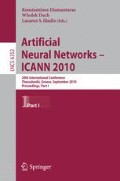Abstract
A novel approach to color image segmentation is proposed and formulated in this paper. Conventional color segmentation methods apply SOFMs – among other techniques – as a first stage clustering in hierarchical or hybrid schemes in order to achieve color reduction and enhance robustness against noise. 2-D SOFMs defined upon 3-D color space are usually employed to render the distribution of colors of an image without taking into consideration the spatial correlation of color vectors throughout various regions of the image. Clustering color vectors pertaining to segments of an image is carried out in a consequent stage via unsupervised or supervised learning. A SOFM defined upon the 2-D image plane, which is viewed as a spatial input space, as well as the output 3-D color space is proposed. Two different initialization schemes are performed, i.e. uniform distribution of the weights in 2-D input space in an ordered fashion so that information regarding local correlation of the color vectors is preserved and jointly uniform distribution of the weights in both 3-D color space and 2-D input space. A second stage of Density-Based Clustering of the nodes of the SOM (utilizing an ad hoc modification of the DBSCAN algorithm) is employed in order to facilitate the segmentation of the color image.
Access this chapter
Tax calculation will be finalised at checkout
Purchases are for personal use only
Preview
Unable to display preview. Download preview PDF.
References
Otsu, N.: A Threshold Selection Method From Gray-Level Histograms. IEEE Trans. Syst. Man Cybernet. 9(1) (1979)
Kerre, E.E., Nachtegael, M. (eds.): Fuzzy Techniques in Image Processing. Series Studies in Fuzziness and Soft Computing, vol. 52. Springer, Heidelberg (2000)
Tizhoosh, H.R.: Fuzzy Image Processing: Introduction in Theory and Applications. Springer, Heidelberg (1997)
Canny, J.R.: A Computational Approach to Edge Detection. IEEE Transactions on Pattern Analysis and Machine Intelligence 8(6), 679–698 (1986)
Adams, R., Bischof, L.: Seeded Region Growing. IEEE Trans. Pattern Analysis and Machine Intelligence 16(6), 641–647 (1994)
Beveridge, J.R., et al.: Segmenting Images Using Localizing Histograms and Region Merging. Int’l J. Compt. Vision 2 (1989)
McInerney, T., Terzopoulos, D.: Deformable Models in Medical Image Analysis: A Survey. Medical Image Analysis 1(2), 91–108 (1996)
Mumford, D., Shah, J.: Optimal Approximations by Piecewise Smooth Functions and Associated Variational Problems. Comm. Pure Appl. Math. 42, 577–684 (1989)
Geman, S., Geman, D.: Stochastic Relaxation, Gibbs Distributions and the Bayesian Restoration of Images. IEEE Transactions on Pattern Analysis and Machine Intelligence 6, 721–741 (1984)
Dempster, A., Laird, N., Rubin, D.: Maximum Likelihood From Incomplete Data Via The EM Algorithm. Journal of Royal Statistical Society, Series B 39, 1–38 (1977)
Osher, S., Sethian, J.A.: Fronts Propagating with Curvature Dependent Speed: Algorithms Based on Hamilton-Jacobi Formulations. Journal of Computational Physics 79, 12–49 (1988)
Brox, T., Weickert, J.: Level Set Based Image Segmentation with Multiple Regions. In: Pattern Recognition, 415–423 (2004)
Vincent, L., Soille, P.: Watersheds in Digital Spaces: An Efficient Algorithm Based on Immersion Simulations. IEEE Trans. Pattern Analysis and Machine Intelligence 13(6), 583–598 (1991)
Serra, J.: Image Analysis and Mathematical Morphology. Academic, New York (1982)
Stephanakis, I.M., Anastassopoulos, G.K.: Watershed Segmentation of Medical Images With On-The-Fly Seed Generation and Region Merging. WSEAS Transactions on Information Science and Applications 1(1), 303–308 (2004)
Bounsaythip, C., Alander, J.T.: Genetic Algorithms in Image Processing - A Review. In: Proc. Of the 3rd Nordic Workshop on Genetic Algorithms and their Applications, Metsatalo, Univ. of Helsinki, Helsinki, Finland, pp. 173–192 (1997)
Sturm, P., Priese, L.: Properties of a Three-Dimensional Island Hierarchy for Segmentation of 3-D Images with the Color Structure Code. In: Van Gool, L. (ed.) DAGM 2002. LNCS, vol. 2449, pp. 274–281. Springer, Heidelberg (2002)
Robertson, A.R.: The CIE 1976 Color-difference Formulae. Color Research and Applications 2, 7–11 (1977)
Tominaga, S.: Color Classification of Natural Color Images. Color Research and Applications 17, 230–239 (1992)
Kohonen, T.: Self-Organizing Maps. Springer Series in Information Sciences. Springer, Berlin (1995)
Yin, H.: ViSOM – A Novel Method for Multivariate Data Projection and Structure Visualization. IEEE Trans. Neural Networks 13(1), 237–243 (2002)
Tenenbaum, J.B., de Silva, V., Langford, J.C.: A Global Geometric Framework for Nonlinear Dimensionality Reduction. Science 290, 2319–2323 (2000)
Ester, M., Kriegel, H.-P., Sander, J., Xu, X.: A Density-Base Algorithm for Discovering Clusters in Large Spatial Databases With Noises. In: Proceedings of the International Conference on Knowledge Discovery and Data Mining, pp. 226–231 (1996)
Ester, M., Kriegel, H.-P., Sander, J., Xu, X.: Clustering for Mining in Large Spatial Databases. KI-Journal 1, 18–24 (1998)
Ye, Q., Gao, W., Zeng, W.: Color Image Segmentation Using Density-Based Clustering. In: Proceedings ICASSP, Hong Kong, Vol.3, pp. 345–348 (2003)
Author information
Authors and Affiliations
Editor information
Editors and Affiliations
Rights and permissions
Copyright information
© 2010 Springer-Verlag Berlin Heidelberg
About this paper
Cite this paper
Stephanakis, I.M., Anastassopoulos, G.C., Iliadis, L.S. (2010). Color Segmentation Using Self-Organizing Feature Maps (SOFMs) Defined Upon Color and Spatial Image Space. In: Diamantaras, K., Duch, W., Iliadis, L.S. (eds) Artificial Neural Networks – ICANN 2010. ICANN 2010. Lecture Notes in Computer Science, vol 6352. Springer, Berlin, Heidelberg. https://doi.org/10.1007/978-3-642-15819-3_66
Download citation
DOI: https://doi.org/10.1007/978-3-642-15819-3_66
Publisher Name: Springer, Berlin, Heidelberg
Print ISBN: 978-3-642-15818-6
Online ISBN: 978-3-642-15819-3
eBook Packages: Computer ScienceComputer Science (R0)

